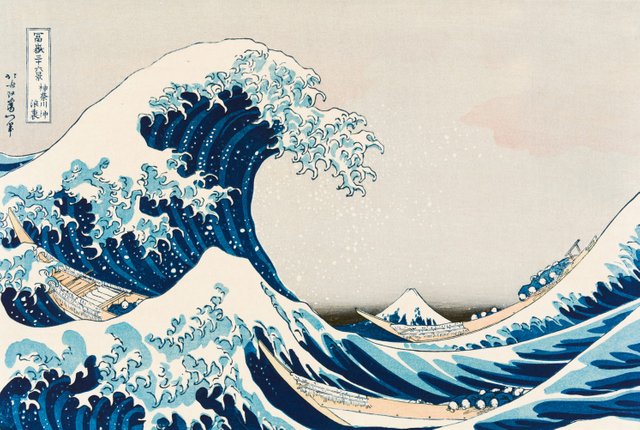The Kanagawa Great Wave (Japanese Kanagawa Oki Nami Ura, literally Under a Wave Off Kanagawa) is a famous woodblock print by the Japanese artist Hokusai.

Published somewhere between 1830 and 1833 (during the Edo period), it is an example of ukiyo-e art. The work is the first of Hokusai's series Thirty-six views of Mount Fuji (Fugaku sanjurokkei), and the most famous of the artist Hokusai.
This woodcut is one of the most recognized works of Japanese art in the world. It represents a huge wave threatening boats near the Kanagawa Prefecture of Japan. Although sometimes referred to as a tsunami, the wave is, as the title of the picture mentions, more likely to be a big okinami (literally wind wave). As in all the prints of the series, it represents the region around Mount Fuji in particular conditions and the mountain itself appears in the background.
Copies of the work are included in many Western collections, including the Metropolitan Museum of Art in New York, the British Museum in London, the Art Institute in Chicago, and Claude Monet's house in Giverny, France.
The UKIYO-E
Japanese term meaning floating world image, ukiyo-e is a Japanese printing technique that was very popular during the Edo period.
The woodblock printing technique was introduced in Japan in the 8th century from China and is mainly used to illustrate Buddhist texts. As early as the 17th century, the technique was used to illustrate poems and novels. It is during this period that we really see the rise of the ukiyo-e, which reflects the life and interests of the lower classes of society: traders, artists and Ronin, who put to the point of their own art and their own literature in urban areas such as Edo (Tokyo today), Osaka and Sakai.
Around 1670, the first of the great masters of the ukiyo-e, Hishikawa Moronobu, appears. Moronobu produces prints on a single leaf: flowers, birds, female forms and shunga erotic scenes. This type of printing in black ink is done on white paper and, later, the artist adds different colors by hand. In the late 18th century, techniques were developed to allow the printing of multicolored prints known as nishiki-e.
@siavach, Art Lover, Salsa Dancer and Photographe